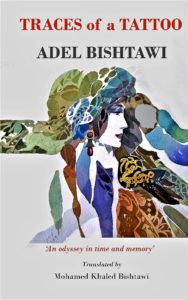
Fathers, Sons, the Memory, and Love in the Computer Age
𝗧𝗥𝗔𝗖𝗘𝗦 𝗢𝗙 𝗔 𝗧𝗔𝗧𝗧𝗢𝗢 𝗕𝗬 𝗔𝗗𝗘𝗟 𝗕𝗜𝗦𝗛𝗧𝗔𝗪𝗜
Reviewed by the distinguished Moroccan literary critic Mohammed Alloutt
Traces of a Tattoo is no ordinary novel. Evoking the example of giant literary Arabic works such as Cities of Salt by Abdulrahman Munif, The Boys of our Neighbourhood by Najib Mahfouz, Midday Spectra by Bahoush Yassin (Morocco), it is an odyssey in time and memory unravelling the story of two generations (fathers and sons) over the full length of 554 pages.
At a deeper level, it is a frantic and introspective exposition of two souls torn between the past and the present. Both are gripped by the machinations of a destiny which had long swept away their love but finally came back to bestow a fresh version on the offspring they have had from different partners. Traces of a Tattoo, in other words, is a complex novel that shows how man is capable of surrendering to his own destiny at times and holding firm at others.
The main theme of Traces of a Tattoo is a love story told along traditional, romantic lines. As such, the novel can hardly to be said to offer something new. But- and here the excitement begins – the author, Adel Bishtawi, had enough command of his craft that he was able to use a light story as a support and a facade for a fictional backdrop that is characterised by marked intensity, profound human dimension, a wealth of philosophical knowledge, tightened sensitivity and a language of extreme beauty. Most importantly, this fictional backdrop employs a technique of duality which opens vast domains for interpretations that encompass a multitude of subjects- the conflict between generations, the failures of the fathers, the ambitions of the sons, the agonies of memory, a head-on collusion with destiny and love in the computer age.
The novel focuses on four main characters from two different generations. The central characters are Hisham and his one-time sweetheart, Alia. They are old stock embodying ultimate failure (loss of their love) suffered under time and social circumstances marked by obstacles, deterrents and disappointments. Along their side is a younger generation: Wissam, a son born to Hisham from an English wife who has since passed away, and Aroub, Alia’s daughter from a husband she married after the collapse of her love for Hisham.
Nonetheless, the ex-lovers are served a reunion in London and the spontaneous rendezvous takes place in the presence of their offspring, giving the old story a chance to resurface. And resurface it does albeit dual, inversive and reflective-the destiny of man once again assuming its role in the ever spinning cycle of life.
It is this multi-layered plot with all its excitement and suspense that gives Traces of a Tattoo its fictional depth. What we are presented with is a literary work that tackles anew the most forceful concept a novel could aspire to handle- the double. The concept which has been treated by, among others, such novels as Searching for Waleed Masoud by Jabra Ibrahim Jabra, Architectural Spirits by Saleem Barakat, and The Escaping Light by Mohammed Bradeh.

Image credit: Sonia_D_private_share
The Double
What do I mean by the double? It is simply the image of the self-juxtaposition against another entity, or simply, the other. But this other is not necessarily the West as has been depicted by Arabic novels dealing with the conflict of East versus West such as Mohammed Zafzaf’s The Woman and the Rose, Yihya Haqi’s The lantern of Umm Hashem, and Taib Saleh’s The Season of Migrating to the North. Rather, the other here is both intricate and varied. Adel Bishtawi`s Traces of a Tattoo actually engages in a dual treatment of the concept of the double and the image of the other. The latter, in particular, is approached from two axes, the first being an East-East axis as dramatised by the older generation vis-à-vis the younger generation, taken as twos- father and son, mother and daughter. The second is an East-West axis where the Arab characters are placed in juxtaposition against Western counterparts such as Arlene and Jacky.
Meanwhile, the concept of the double allows for a more expanded application. It encompasses numerous contrasting elements like the one where the double takes a temporal dimension, namely, the past versus the present with each having its unique values, symbols and contextual interpretations. Another duality where the double is again active, this time within the confines of the memory, takes the form of a clash between past experiences that carry romantic values, a heavy weight of emotions and a fully-laden conscience, on the one hand, and contrasting experiences of the present, on the other. There is yet a third and last example, a duality at the cultural, social and political level. It is a contrast of two societies: a conciliatory Arab society torn between traditional conservatism and an outlook that is modern but damaged, vis-à-vis a Western society whose values appear harmonic, at least within their own context.
It is my opinion that through the concept of the double or the interactions and dynamism of the other’s image, it becomes possible to interpret the fictional wealth of Traces of a Tattoo by a powerful formula of knowledge and philosophy that allows placing this literary work within a sphere of learning which interacts with the present Arab social reality with all its questions, concerns and life’s pendular jitters.
To give an example of the novel’s dramatisation of the double concept, I would refer the reader to chapters 8 and 9. The first reflects a duality in the form of a mirror-type meeting between Eastern Aroub and Western Arlene, while the second reflects the Arab woman’s inner struggle through a realistic image embodied by none other than Aroub herself and an imaginary entity taken out of the common Eastern cultural heritage of One Thousand Nights and One Night (The Arabian Nights). This example alone is ample and concrete evidence of the author’s ability to address man’s duality and its consequences. His aim is to help us imagine the intensity of both the struggle raging deep within the characters’ psychological and cultural entity and their no less intense conflict between what is real and what is desired and between values that are conflicting, opposed and changing.
The author employed several tools to build up a narrative plot that is psychologically and emotionally dense and effective, namely imagination, dream and introspection. It is these foundations that gave Traces of a Tattoo its expanded fictional realm where the characters, more specifically their psychological entities, roam dreamily, imaginatively and introspectively. This roaming takes up a large part of the novel and becomes a basic material that allows for discovering the characters from within.
Tools of Writing
Meanwhile, the author resorts to other tools to give us a complete and dynamic knowledge of the characters externally as well as their inter- relations. One such tool is making his characters revisit their memories and engage in retrospective talking. Another is relaying heavily on the expressive aspects of dialogue. Combined, this multitude of elements and tools- the memory, the dialogue, the dream, retrospection that are tuned by the plot, endow the novel with a rich variety which save the reader from being dragged into the trap of boredom by the large number of pages.
The novel concludes with the younger generation bypassing failure. It ends optimistic and confident in man’s ability to overcome the shortcomings of life. For the oppressed souls, the failures of the past have turned into present-day victories achieved against the very helplessness lingering within their own actions. These victories, like everything else in the novel, are twice as large.

But yet again, the novel does not leads us to believe that victories are easy to attain- far from it. The dreamy, romantic adventures of the characters are never immune from reality’s violent, roaring shocks and painful jolts. We are all along made to realise that the victories attained by man in reality start by overcoming the helplessness and defeat within, and that this is the only way victories are made to lead to true salvation shielded against setbacks and disappointments.
But the most entertaining aspect of Traces of a Tattoo lies in its treatment of love in the computer age. While the novel invokes the Arab cultural legacy in its main stream and folklore versions as well as such remarkable masterpieces of imaginative heritage as The Arabian Nights, it also invokes a different culture, one that is purely logical and programmed like the computer. Here the novel’s love story, while not totally void of entertainment and sarcastic overtures, takes proportions unfamiliar in Arabic literary works. It poses an amusing question: is love programmable, after all? The answer given, with all its supporting wealth of knowledge, serves to refocus on the heart-mind conflict. It does so in an introspective dramatisation that attempts to pinpoint the location of the age-old argument’s elements of strength: do they lie in human warmth and intimacy; or do they lie in lifeless machines? The interaction between love and the computer is indeed the most enjoyable part of Adel Bishtawi`s novel.
What the novel says here is that man is unique in his nature. Man may draw the symbols of his love from the romantic world of The Arabian Nights or from cartoons created by the computer, but man would remain true to his nature. The essential and intrinsic will linger and the momentary and temporary will dissipate in the labyrinth of life.
Translated by Muhammad Khaled from original text published by the Moroccan newspaper Al Sahraa. T-T-98-19-07-10.
Image credit: Sonia_D_private_share